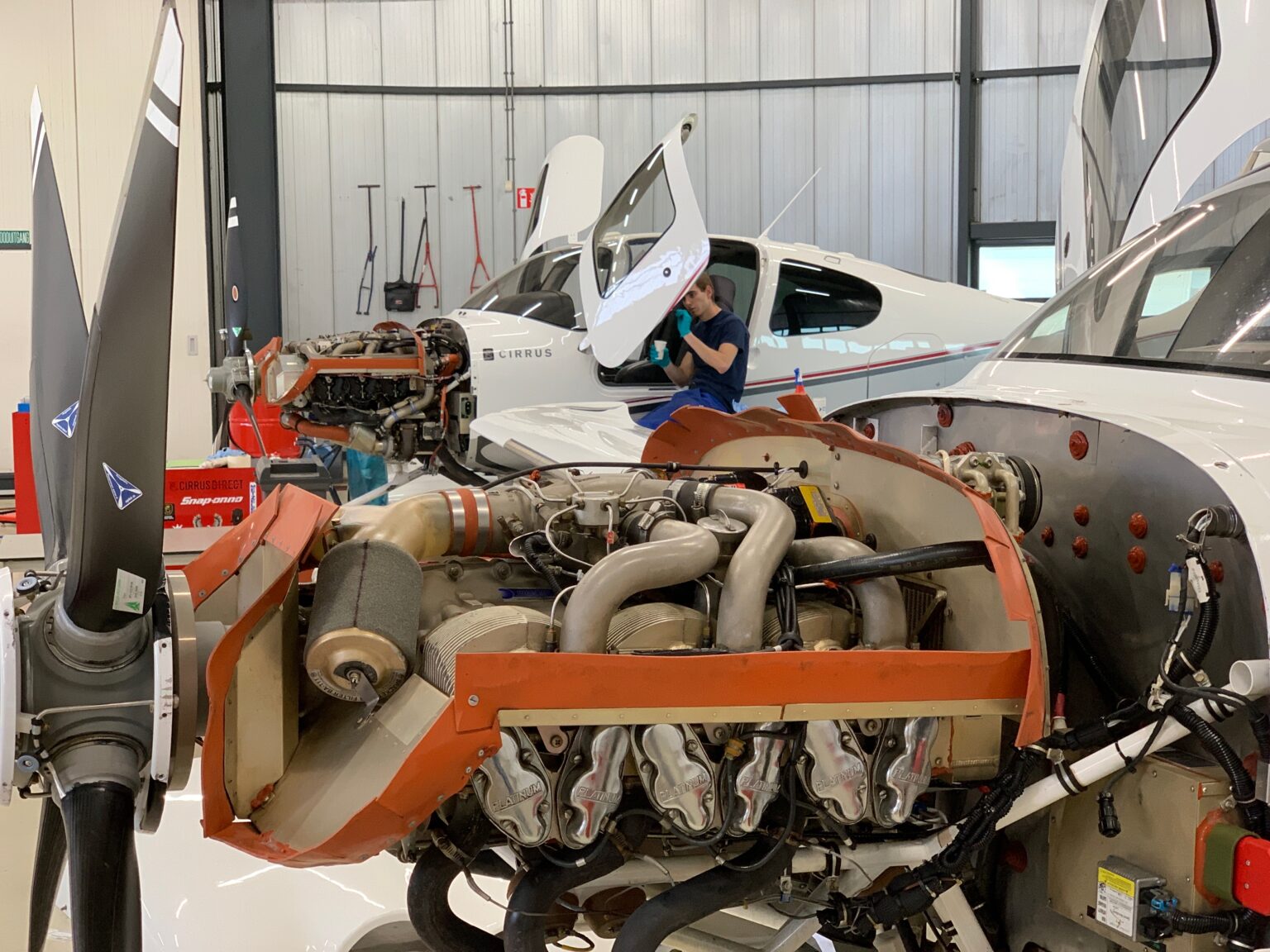The Evolution of Continental’s Big Bore Engines
When the postwar general aviation boom of the 1950s and 1960s created a demand for faster, heavier, and more capable aircraft, Continental Motors responded with a new generation of six-cylinder, fuel-injected engines. These powerplants—today grouped under the nickname “big bore” Continentals—have since become some of the most important piston engines in high-performance general aviation.

TCM TSIO-520
From the IO-470 to the IO-520
The story begins with the IO-470, introduced in the late 1950s. At 471 cubic inches of displacement and about 250 horsepower, it was essentially the “bridge” between Continental’s smaller four- and six-cylinder designs and what was to follow. Installed in aircraft like the Beech Debonair and early Bonanzas, the IO-470 set the stage for larger displacements.
Building on that foundation, Continental released the IO-520 in the early 1960s. With 520 cubic inches and outputs ranging from 285 to 310 horsepower, it provided the power needed for aircraft like the Beechcraft Bonanza and Baron, Cessna 185/206/210, and many others. Its design philosophy was straightforward: the same basic architecture as the IO-470, but bigger, stronger, and optimized for fuel injection. It quickly became a workhorse of the general aviation fleet.
Turbocharging and Geared Variants
As demand grew for high-altitude performance, Continental introduced turbocharged versions: the TSIO-520, offering 285–325 horsepower with the ability to maintain sea-level power well into the flight levels. These engines powered Cessna 210s, twin-engine Barons, and other touring aircraft.
For even more power, Continental developed the GTSIO-520, a geared, turbocharged variant delivering up to 375 horsepower. While it offered impressive thrust for pressurized twins like the Cessna 421 Golden Eagle, its geared drive system introduced complexity and higher maintenance requirements, making it less popular over the long term.
The IO-550: Refinement and Growth
By the 1980s, aircraft manufacturers sought both smoother operation and more horsepower. The result was the IO-550, an enlarged development of the IO-520, with 552 cubic inches and outputs between 280 and 310 horsepower. Its broader torque curve and higher reliability made it a natural fit for modern single-engine aircraft such as the Beech G36 Bonanza and, later, the Cirrus SR22.
Turbocharged versions—the TSIO-550—appeared in the 1990s, producing up to 350 horsepower and powering advanced aircraft like the Columbia/Corvalis 400 and Cirrus SR22T. These designs emphasized altitude capability, speed, and efficiency in the new generation of composite, high-performance singles.
Experimenting with the Future: FADEC
In the early 2000s, Continental experimented with Full Authority Digital Engine Control (FADEC) through the IOF-550 and TSIOF-550 models. FADEC promised simplified operation—single-lever power management and automated mixture control—but adoption was limited, partly due to higher costs and maintenance complexity. Nevertheless, these engines represented Continental’s vision of modernizing piston powerplants for the 21st century.
Legacy and Impact
Continental’s big bore engines—from the IO-470 through the IO-520 and IO-550 families—have powered tens of thousands of aircraft over more than six decades. They remain the backbone of the high-performance piston market, known for their characteristic smoothness, durability, and ability to deliver reliable power in demanding conditions.
Even as aviation looks toward new technologies like diesel and electric propulsion, the Continental big bores stand as icons of the golden era of piston aviation—and they continue to evolve in today’s most advanced piston singles.
And here’s a list of the !”Big Bore” Contis.
Continental “Big Bore” Avgas Engines
IO-520 Family
- Type: Fuel-injected, 6-cylinder, horizontally-opposed, air-cooled.
- Displacement: 520 cu in (8.5 L).
- Typical Power: 285–310 hp.
- Compression Ratio: 8.5:1 (varies by model).
- Weight (dry): ~430–450 lb.
- Introduced: Mid-1960s.
- Notes:
- Successor to IO-470.
- Popular in Beech Bonanza, Baron, Cessna 185/206/210.
- Variants include TSIO-520 (turbocharged) up to 325 hp.
IO-550 Family
- Type: Fuel-injected, 6-cylinder, horizontally-opposed, air-cooled.
- Displacement: 552 cu in (9.0 L).
- Typical Power: 280–360 hp.
- Compression Ratio: 8.5:1 (varies by model).
- Weight (dry): ~430–470 lb.
- Introduced: Late 1980s.
- Notes:
- Evolution of IO-520 with slightly larger displacement.
- Common in Cirrus SR22, Beech G36 Bonanza, Cessna 182/206 upgrades.
- Variants:
- IO-550-N (310 hp, Cirrus SR22).
- TSIO-550 (turbocharged, 350 hp+, in Cirrus SR22T, Columbia/Corvalis).
- Tornado Alley Turbo (STC) popular aftermarket mod.
- IOF-550 (FADEC-controlled).
TSIO-520 Family
- Type: Turbocharged, fuel-injected, 6-cylinder.
- Displacement: 520 cu in.
- Typical Power: 285–325 hp.
- Compression Ratio: Usually 7.5:1 (lowered for turbocharging).
- Notes:
- Installed in Cessna T210, Beech Baron 58TC, Malibu conversions.
- Well known for higher fuel burn but excellent high-altitude performance.
TSIO-550 Family
- Type: Turbocharged, fuel-injected, 6-cylinder.
- Displacement: 552 cu in.
- Typical Power: 310–350 hp (up to 360 hp in some variants).
- Notes:
- Modern turbocharged big bore.
- Used in Cirrus SR22T, Columbia 400, Cessna TTx.
- FADEC option (TSIOF-550).
- Designed for higher critical altitudes and smoother operation.
Other Variants in the Big Bore Line
- IOF-550 → Full FADEC control (rare, early 2000s Columbia/Corvalis).
- TSIOF-550 → Turbocharged + FADEC.
- GTSIO-520 → Geared, turbocharged (375 hp, used in Cessna 404 Titan, 421 Golden Eagle).
- Known for high maintenance demands.
- IO-470 → Often considered the “entry” to big bore class (470 cu in, ~250 hp). Some classify it as “medium bore,” but it’s the direct ancestor of 520/550.
Summary Table
| Engine | Disp. (cu in) | Power (hp) | Induction | Notes |
|---|---|---|---|---|
| IO-470 | 471 | 230–260 | NA / FI | Ancestor, Bonanza/Debonair |
| IO-520 | 520 | 285–310 | NA / FI | Core big bore |
| TSIO-520 | 520 | 285–325 | Turbo FI | Turbocharged version |
| GTSIO-520 | 520 | 375 | Geared Turbo | Complex, high mx |
| IO-550 | 552 | 280–310 | NA / FI | Cirrus SR22, Bonanza |
| IOF-550 | 552 | 310 | NA / FADEC | Rare |
| TSIO-550 | 552 | 310–350 | Turbo FI | Cirrus SR22T, Columbia 400 |
| TSIOF-550 | 552 | 310–350 | Turbo FADEC | Advanced, limited |

